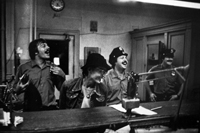Try to remember when crime was raging but cops were heroes. Jill Freedman thinks she can. She followed them day after day and night after night, from drunks and psychos to dark streets and roach-infested hallways. She followed them from 1978 to 1981, in two of Manhattan’s toughest precincts and three of its toughest years. She dedicates her photos to them, unabashedly, at Higher Pictures through October 29. In print, the titles expand into odes to a vanished New York, broken into lines like poetry.
They worked Midtown South, a no-man’s-land between Penn Station and Time Square—the Garment District by day and, by night, the Port Authority and seamy hotels. They worked the East Village, before the East Village art scene, when kids played with toy guns and pointed them at a squad car with impunity. They could not bring safety, but they could bring (to borrow from her titles) a Human Touch to the sleeping woman who may never have felt it again. They could not rescue lives, but they could restrain, if only for a moment, the child Always Running Away, and they could offer a grateful suspect a Free Lunch. They could not do much about crime, but they could battle Boredom at a parade, the sawhorse framing a face that looks more like George Harrison than a victim of poverty. They could not save a Suicide, but they could act as Partners, hurtling a wall together like superheroes.
Maybe it does recall one’s favorite comic book, in which only a Jersey Driver can interrupt the Gotham City story. Two policemen part their uniforms to reveal Hell’s Angels t-shirts, like secret identities. A man raging on his back on the street has the expression of the Joker. Light reflects off the silhouette of the one overt horror, the suicide, like off a masked villain, and the struggle is unending. The heroes and villains laugh together, even at a bank robbery. The manStabbed Twice in the Guts, his eyes a drugged or otherworldly glow, will live to fight another day.
I remember, too, or so I like to think. I had returned to the city, after college and too many trips through the Port Authority. I knew the East Village, if only from too many early mornings fighting off the sounds in my head. I lived south of Midtown South, in an illegal loft above a topless bar, where I never once went in. It seemed a gentler, more affordable time, when I could amuse the homeless by running laps around Madison Square, to pretend cheers. I did not have to choose between high-rise condos and the Museum of Sex (because neither existed), I did not have to hurry through too many galleries to be fair to or to believe in art, and I did not have to call it Chelsea.
I wonder, though, just as I wonder about the gratitude and the laughter. I wonder about other memories than hers, of crime and of racial profiling continuing to this day. It took a later commissioner under Mayor Dinkins and then Mayor Giuliani to reverse the ideal of efficiency that kept police so often off the streets entirely, in their cars, and behind the blue wall of silence. For Diane Arbus, a smile could turn into a freak show and a camera could confront both heroes and villains, not to mention the viewer. Not for Freedman, born in 1939, who helped to create the heroes along with the smiles. Look again, and all parties are posing for the camera, even after a Bar Fight, 2 AM, Avenue C.
“Street Cops” shares the conventions of the tabloids, in composition as well as complicity. Freedman crops a scene to frame the central actors, and the city falls behind them as it may. She punches them up, too, as with a crime scene as Pietà. She allows them their innocence, a cigar in place of a pistol. Those visceral conventions, though, for all my objections, have their place in memory. After all these years of Pop Art, politics, and appropriation, welcome back to tabloid New York City.

